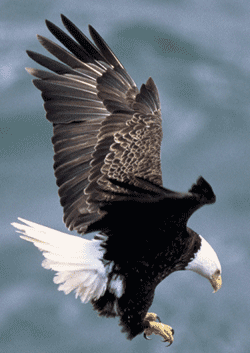|
American Bald Eagle - status in your state The bald eagle was made the national bird of the United States in 1782. The Bald Eagle is protected by the United States government and many state governments. Bald Eagle video on Youtube. |
The bald eagle first gained federal protection in 1940, under the Bald and Golden Eagle Protection Act. The law curbed illegal hunting and shooting of eagles for their feathers. They began to recover. But eagles, as well as other birds, soon fell victim to another threat: DDT. After World War II, the USDA encouraged spraying DDT (dichloro-diphenyl-trichloroethane) to control mosquitoes in coastal areas. Farmers used DDT to control agricultural pests. When it rained, DDT would wash off the soil and into the waterways. There, it was absorbed by aquatic plants and animals. Fish ate the plants and animals, and then eagles ate the fish. When eagles ate contaminated fish, they would then be poisoned. DDT prevented the proper formulation of calcium necessary to produce strong eggshells. Consequently, the thinned eggshells cracked when an adult bird tired to incubate them. Few chicks were born. The Environmental Protection Agency banned the use of DDT on December 31, 1972. |
 |
Biologist and writer, Rachel Carson raised the alarm in her historic book Silent Spring. Major chemical companies attacked her, but she stuck to her guns and DDT was banned. 3 |
The U.S. Fish and Wildlife Service officially listed the bald eagle as a national endangered species in 1973. A “threatened” species is one that is likely to become endangered in the foreseeable future. Through captive breeding programs, reintroduction of eagles into their historic habitat, protecting nest sites during the breeding season, conserving roosting habitat for food and shelter and enforcing the law against those people who illegally killed eagles, the Endangered Species Act provided protections for the bald eagle. The last year the FWS conducted a national bald eagle census was 2000. They estimated there were 6471 nesting pairs of bald eagles. In 2007, they announced that they were removing the American Bald Eagle from the Endangered Species List, because there was an estimated high of 9,789 breeding pairs. Estimated number of nesting pairs in each state | Bald Eagle status 2004 This is a national population figure. Look into the status of Bald Eagles in your state.
Further thinking Bald eagles, red-tailed hawks offer spectacle as they battle for Harmar nest Should someone intervene? Bald Eagles regularly nest along the Susquehanna River in PA. In 2011, a growing number of fishermen and environmentalists were concerned due to the decline in smallmouth bass populations and the blotches that were appearing on the fish. What implications could this have for bald eagles in Pennsylvania?
Eaglecam | National Bald Eagle Management Guidelines | Bald Eagles @ NGS Basic Ecology A Free Online Textbook | Indicator Species Extensions:
|
All trademarks, copyright and logos belong to their respective owners.
Internet Hunts / Nature / Water / Problem based Learning / Famous Pennsylvanians / Civics / Puzzles & Projects / Home
Posted by Cynthia J. O'Hora 9/2007, Updated 5/2023released for noncommercial use by nonprofit organizations & individuals
Cited Sources:
1. Symbols of U.S. Government: The Bald Eagle
2. Bald Eagle, (Haliaeetus leucocephalus)
3. Rachel Carson: A Conservation Legacy
4. Service Reopens Comment Period on Removing the Bald Eagle from the Endangered Species Act
6. Bald Eagle Soars Off Endangered Species List
7. Government Vs. Environment By Donald R. Lelal
![]() Save a tree - use a Digital Answer Sheet: Highlight the text of the questions on this web page, copy them - Edit .. Copy. Open a text document or word processing document. Paste the questions into the blank document. Answer the questions in the word processing document in a contrasting color ( not yellow) or font (avoid fancy fonts like:
Save a tree - use a Digital Answer Sheet: Highlight the text of the questions on this web page, copy them - Edit .. Copy. Open a text document or word processing document. Paste the questions into the blank document. Answer the questions in the word processing document in a contrasting color ( not yellow) or font (avoid fancy fonts like: ![]() , Symbol,
, Symbol, ![]() or
or ![]() . Save frequently as you work. I do not like losing my work. You will not like it either. Put your name and the date in a header. Bad things happen. Retain a copy of your work on your computer. Submit your assignment via a class electronic drop box or email attachment. Proof your responses. It is funny how speling errors and typeos sneak in to the bets work.
. Save frequently as you work. I do not like losing my work. You will not like it either. Put your name and the date in a header. Bad things happen. Retain a copy of your work on your computer. Submit your assignment via a class electronic drop box or email attachment. Proof your responses. It is funny how speling errors and typeos sneak in to the bets work. ![]() Make Your Own Printed answer sheet
Make Your Own Printed answer sheet
Standards:
NCTE Standard 3 - Students apply a wide range of strategies to comprehend, interpret, evaluate, and appreciate texts.
NCTE Standard 8 - Students use a variety of technology and information resources to gather, synthesize, and communicate knowledge.
PA Academic Standards - History, Civics and Government, Science and Technology, Ecology and Environment, Reading Writing, Mathematics
ISTE Standard 3 - Technology productivity tools, ISTE Standard 5 - Technology research tools
Information Literacy Standards - Independent Learning
